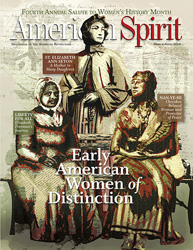Guest Blog: Crafting a Custom Cover for the March/April American Spirit
Since 2011, the March/April issue of American Spirit has been devoted to Women’s History Month. This annual edition quickly has become a staff favorite. We’re thrilled any time our pages can bring to life a lesser known chapter of Revolutionary or early American history, and that excitement only increases at the chance to showcase the women of these eras, whose bravery, wisdom and compassion makes them every bit as worthy of appreciation as their male counterparts. There’s one factor, however, that makes creating the March/April issue a bit of a challenge: In many cases there are few images available to pair with the engrossing stories about these early American women.
This year, Art Director Kerri Davis at Hammock, Inc., our partner in producing American Spirit and Daughters newsletter, devised an inspired solution to the challenge. Hammock commissioned custom, original illustrations not only for the March/April cover, but also the opening pages of three of the issue’s female focused articles. We think this qualifies the 2014 Women’s History Month issue as a bona fide work of art!
Whereas the covers of the three previous Women’s History Month issues have featured a silhouette or portrait of a single woman, we wanted to take a different approach this year. (For those who are curious, the previous cover girls were Abigail Adams in 2011, Martha Washington in 2012 and Anna Claypoole Peale’s miniature of Margaret Oliver Hicks in 2013.) Editorial features on former slave Elizabeth Freeman, Cherokee peacekeeper Nan-ye-hi and Catholic education pioneer St. Elizabeth Ann Seton, in addition to an excerpt from Nancy Rubin Stuart’s book Defiant Brides, about Lucy Flucker Knox and Peggy Shippen Arnold, provided a surplus of inspiration.
 Searching for ways to incorporate elements of these articles into one unique design, Kerri decided to explore a collage effect as a creative way to meet the editorial challenge of illustrating several women of diverse backgrounds. Kerri browsed the website Behance, which showcases portfolios of creative professionals from all over the world. That’s where she came across a project by Brazilian illustrator Antonio Rodrigues called “Concrete Butterflies,” combining typography and floral motifs in portraits of women. The design team envisioned portraits of a diverse trio of early American women as the primary focus of the illustration. Rodrigues used existing images of Freeman, Nan-ye-hi and Seton for reference in the process of crafting his portraits. Into the background he incorporated images of the DAR Americana Collection’s letters between Henry and Lucy Knox.
Searching for ways to incorporate elements of these articles into one unique design, Kerri decided to explore a collage effect as a creative way to meet the editorial challenge of illustrating several women of diverse backgrounds. Kerri browsed the website Behance, which showcases portfolios of creative professionals from all over the world. That’s where she came across a project by Brazilian illustrator Antonio Rodrigues called “Concrete Butterflies,” combining typography and floral motifs in portraits of women. The design team envisioned portraits of a diverse trio of early American women as the primary focus of the illustration. Rodrigues used existing images of Freeman, Nan-ye-hi and Seton for reference in the process of crafting his portraits. Into the background he incorporated images of the DAR Americana Collection’s letters between Henry and Lucy Knox.
The Knox letters serve as a subtle but significant component. They introduce typography into the illustration while providing a grounding historical weight to the fresh, modern illustrations. Managing Editor Jamie Roberts notes that they also underscore the importance of remembering early American women’s stories, many of which have been lost, in writing.
Inside the magazine, each woman’s solo illustration incorporates a biographical element. “We like the organic shapes and earthy colors that the illustrator used to convey the backgrounds, which are pretty nuanced, yet distinctive to each woman,” explains Jamie. Behind Elizabeth Freeman is a Colonial New England building, Elizabeth Seton stands in front of a church, and the woodlands of frontier Tennessee provide a backdrop for Nan-ye-hi.
We hope you’ve enjoyed learning more about our fourth annual Women’s History Month issue’s original artwork, in addition to the articles about the extraordinary American women it portrays. The March/April issue is full of material about other remarkable women too, including early female doctor Elizabeth Blackwell, the three generations of women who ran Louisiana’s Laura Plantation, Colonial imposter Sarah Wilson and Today’s Daughter Carolyn Bushman.

 Today's DAR
Today's DAR